Part 99: Why call it now?
Fast forward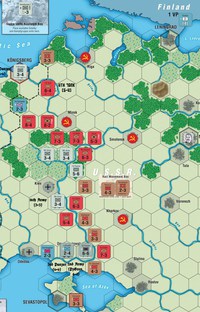
Some of you may ask: why call the game right now? After all, the German situation is dire, but not totally unsalvageable. The Soviets are still in the USSR, and there is a large Axis force still fighting. Surely there is still something to play for?
The answer, however, is that there is no realistic way for the Germans to win.
The only win condition they may still theoretically have a shot at is that if the Soviets do not win by the end of Turn 28, the Germans do instead. And that's all well and fine, you might think, don't they have the entirety of Greater Germany to defend in? That's almost two countries between the Soviets and Berlin!
But if you look at the map below...
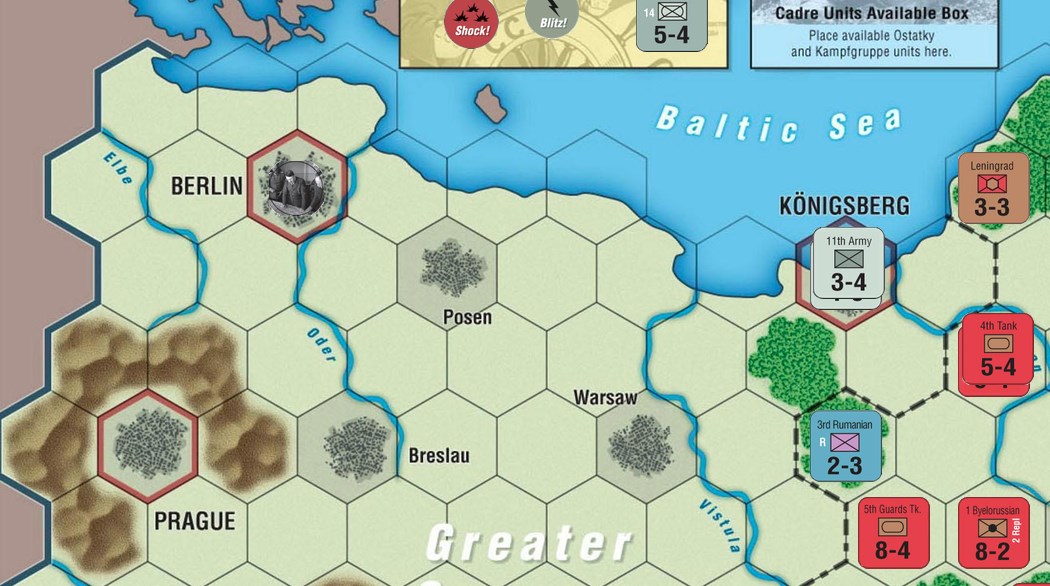
...you'll see that while the Soviet Union is huge, Germany is not. The Soviets are 8 hexes away from Berlin right now, and that means that the Germans can't, on average, give up even a single hex of land a turn.
Still, maybe they can just defend in depth, occasionally counter-attack and try to figure something out? Here's another problem:


Right now they're 4 units down, and even though they're getting one this turn (and a decent one to boot), they'll continue to be weakened. Why?
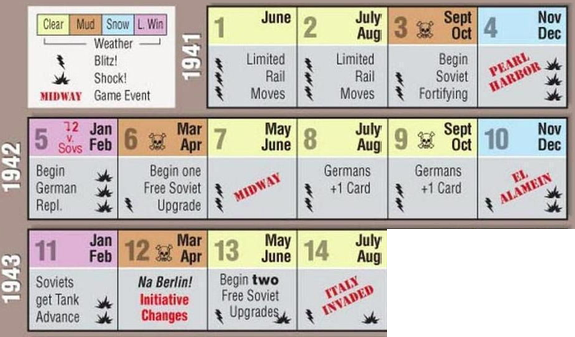
This turn marks the invasion of Italy, which costs them a VP and a card. And this is only the beginning of their troubles. Their units are mostly reduced-strength right now, and having two steps is what allows the Germans to put up a very resilient defence. They won't have the resources to bring those forces back up. Let's take a look at the turn track and see just why.
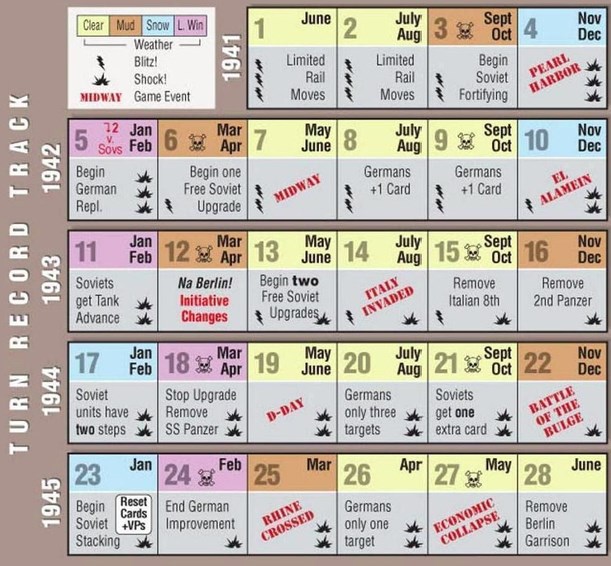
On Turn 15, the Axis start to lose card draws because of No Surrender. In fact, we can safely assume that until the end of the game, pretty much every skull icon means that the Germans lose three cards (maybe save for 1945, if they're lucky). And that turn they also have to remove the 8th Italian... which is dead right now, causing them to lose another card because of that. On Turn 16 they have another blow to take: the 2nd Panzer also leaves the game.
1944 opens with a serious change to the Soviet fighting capabilities: from that point on, their units have two steps. This means, on the one hand, that they have to be re-upgraded if they lose a step (but this can be done with their free upgrades or at a cost of one card discard), on the other - they have a lot more staying power. A curious little rules catch is that this means that any upgraded Soviet units that die on Turn 16 only come back on their weaker side (because destroyed units come back on their reduced-strength side, which they had only just acquired). Turn 18 gives the Axis a tiny little bit of help - the Soviets lose one of their two free upgrades. Of course, this is followed by a kick to the nuts - No Surrender and the loss of SS Panzer. Instead, the Axis get these guys:

A lot wimpier than their Panzer colleagues, but with an interesting gimmick: when they defend, they cause the attack to shift one column to the left. Definitely useful, but not as much as SS Panzer...
On Turn 20, the Germans are fighting a full-blown two-front war and suffer for it. They can only make three voluntary attacks per turn from that point on. Given the sad state of their force, however, that probably wouldn't be as much of a hit.
Regardless of the strategy adopted by the Soviets, I'd estimate that even if they wanted to clean house first, this is the absolute latest that they would get an upgraded unit into Greater Germany. This triggers a bunch of reinforcements:
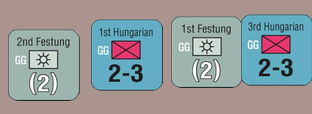
None of these units is particularly strong, though. The German fortresses may seem handy, but they are not the sturdy Soviet forts that prevented the loss of Sevastopol and Leningrad - they only have one step, have to take the first EX result in a battle, and once destroyed, are permanently removed from the game.
Another bunch of interesting effects trigger when the Soviets secure the Ploesti oil fields hex.
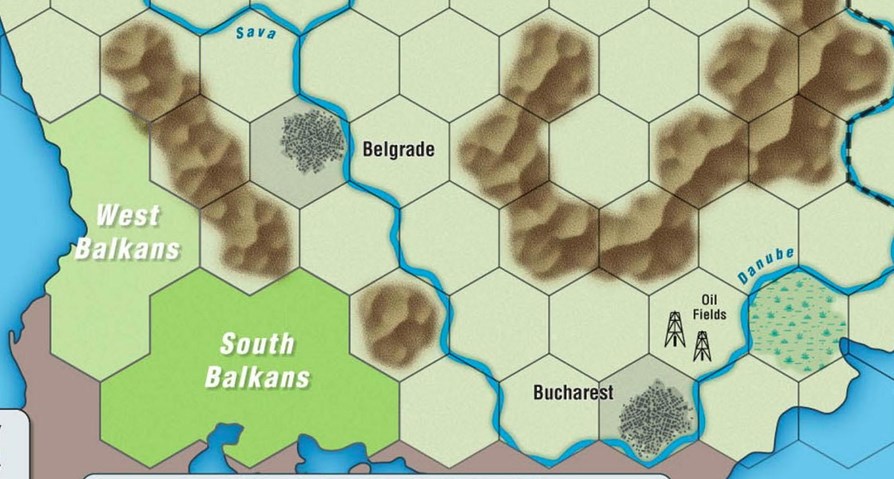
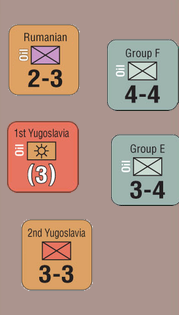
For the Germans, this has some pretty horrible consequences. Their tanks (other than SS Panzer) permanently lose their Armour and Advance bonuses, and even if they manage to reconquer the oil fields, they can only regain the Armour bonus. They also lose all Rumanian units, as the country surrenders to the Soviets. Finally, the two Yugoslav units spawn in the West/South Balkans areas, with the two new German armies pretty much instantly tied up fighting them. The Yugoslavs arrive as fortresses, but if left unchecked, they can flip back to infantry and harass the Germans, as they can draw supply from the two Balkans areas (and nowhere else, so they can't guerilla their way into Berlin). The Soviet Rumanians, by the way, have two steps - but the one displayed is their stronger one.

Once the Soviets take Warsaw, they get the Polish unit. These guys are Soviet Rumanians, though - they only have one step and go to the Turn Track once whacked.
Turn 23 changes the rules of the game a lot. First of all, from that point on, only hexes in Greater Germany count for VP purposes. Second, all cards with the crossed-out "45" icon (e.g.) are removed from the game and replaced with a bunch of new 1945-only cards - of which most provide VPs for holding specific areas, but some are actually useful. Third, it allows the Soviets to stack. Fourth, it generates the last Axis reinforcements wave:

All these units are immediately placed in the respective Cities. The black hexes represent Volkssturm units, a last-ditch force of poorly trained conscripts. They are weak, but they have a unique feature: when a DR is rolled against their hex, it gets converted to no effect, but the VS unit is removed from the game. Berlin Garrison, in turn, is also very important: if the Soviets manage to destroy that unit, they win the game by Killing Hitler.
All this unit spawning has the adverse effect of causing the Germans to only draw one card that turn. This is bad.
Also, from this turn on, the Axis can pay some VPs in their Org Phase to bring back the SS Panzer, which is the one thing they really have going for them at that point.
On Turn 24, the Germans are barred from upgrading their units. They probably won't be able to afford it, anyway.
On Turn 26, they are down to one target. The Reich is so weakened that it can only afford small-scale local offensives.
On Turn 28, the Berlin Garrison is removed from the game and the Soviets may no longer win by Killing Hitler.
That seems to be it! The LP is officially over! Thanks for all your kind words and support, and I'll try to think of something to do next. Stay tuned!